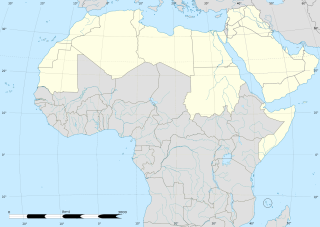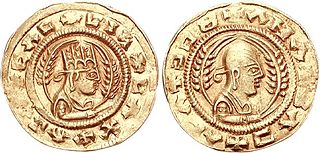
The Arab world, formally the Arab homeland, also known as the Arab nation, the Arabsphere, or the Arab states, consists of the 22 Arab countries which are members of the Arab League. A majority of these countries are located in Western Asia, Northern Africa, Western Africa, and Eastern Africa. The region stretches from the Atlantic Ocean in the west to the Arabian Sea in the east, and from the Mediterranean Sea in the north to the Indian Ocean in the southeast. The eastern part of the Arab world is known as the Mashriq, and the western part as the Maghreb. Arabic is used as the lingua franca throughout the Arab world.
D mt was a kingdom located in Eritrea and northern Ethiopia that existed during the 10th and 5th centuries BC. Few inscriptions by or about this kingdom survive and very little archaeological work has taken place. As a result, it is not known whether Dʿmt ended as a civilization before the Kingdom of Aksum's early stages, evolved into the Aksumite state, or was one of the smaller states united in the Kingdom of Aksum possibly around the beginning of the 1st century.

Arabization or Arabisation describes both the process of growing Arab influence on non-Arab populations, causing a language shift by the latter's gradual adoption of the Arabic language and incorporation of Arab culture, as well as the Arab nationalist policies of some governments in modern Arab states toward non-Arab minorities, including Lebanon, Kuwait, Iraq, Syria, Palestine, Sudan, Mauritania, Algeria, Libya, and the Islamic State of Iraq and the Levant.
Abd al-Aziz, frequently also transliterated Abdul-Aziz, is a male Arabic Muslim given name and, in modern usage, surname. It is built from the words ʽAbd, the Arabic definite article and ʽAzīz "Almighty". The name is commonly abbreviated as "ʽAzīz". The name means "servant of the Almighty", al-ʽAzīz being one of the names of God in Islam, which give rise to the Muslim theophoric names.

Arab diaspora refers to descendants of the Arab emigrants who, voluntarily or as refugees, emigrated from their native lands to non-Arab countries, primarily in Central America, South America, Europe, North America, and parts of Southeast Asia, the Caribbean, and West Africa. In a more specific view, emigrants from Arab countries, such as Sudan or the Palestinian territories, also make up important national groups of their countries' diaspora in other Arab states, such as the Gulf states or Saudi Arabia.

MENA is an English-language acronym referring to the Middle East and North Africa. It is alternatively called the WANA. The MENA acronym is often used in academia, military planning, disaster relief, media planning as a broadcast region, and business writing. Moreover, the region shares a number of cultural, economic and environmental similarities across the countries; for example, some of the most extreme impacts of climate change will be felt in the region.

Habesha peoples is an ethnic identifier frequently employed to refer to Semitic language-speaking peoples mainly found in the highlands of Ethiopia and Eritrea. Historically, the term was applied to predominantly Christian groups, and this usage remains common today. The term is used in varying degrees of exclusion and inclusivity: Most commonly, it includes all highland Semitic language-speaking Christians; sometimes it is employed in an expanded sense to include Muslim communities as well as Christians. At the extremes, the term is currently sometimes employed in a restrictive sense to only refer to speakers of Tigrinya, while recently, some within diasporic communities have adopted the term to refer to all people of Eritrean or Ethiopian origin.
Ayman is an Arabic masculine given name. It is derived from the Arabic Semitic root for right, and literally means righteous, he who is on the right, right-handed, blessed or lucky.

Pre-Islamic Arabia is the Arabian Peninsula prior to the emergence of Islam in 610 CE.
The terms African civilizations, also classical African civilizations, or African empires are terms that generally refer to the various pre-colonial African kingdoms. The civilizations usually include Egypt, Carthage, Axum, Numidia, and Nubia, but may also be extended to the prehistoric Land of Punt and others: the Empire of Ashanti, Kingdom of Kongo, Empire of Mali, Kingdom of Zimbabwe, Songhai Empire, the Garamantes the Empire of Ghana, Bono state and Kingdom of Benin.

The Arab Parliament is the legislative body of the Arab League. At the 19th Arab League Summit in Amman, the Arab states agreed to create an Arab Parliament, and came up with a resolution to give Amr Moussa the Secretary General of the Arab League the power to start and create the Parliament. In 2004, in the ordinary Arab League Summit in Algiers was the official date where all Arab League Members agreed to send their representative to the temporary Parliament sessions that took place in the headquarters of the Arab League in Cairo, Egypt, with each member state sending four members, until the Parliament is reassigned permanently to its under-construction office in Damascus.

Abdelrahman or Abd al-Rahman or Abdul Rahman or Abdurrahman or Abdrrahman is a male Arabic Muslim given name, and in modern usage, surname. It is built from the Arabic words Abd, al- and Rahman. The name means "servant of the most gracious", ar-Rahman being one of the names of God in the Qur'an, which give rise to the Muslim theophoric names.
Amri or AMRI may refer to:
The 2002 Arab Cup was the eighth edition of the Arab Cup football competition, hosted in the nation of Kuwait. The Saudi Arabia, who were the defending champions from the last Arab Cup, again won the title for a 2nd time at the conclusion of the competition.

The Kingdom of Aksum, also known as the Kingdom of Axum or the Aksumite Empire, was an ancient kingdom with its capital at the city of Axum (Aksum). The kingdom was centered in what is now the Tigray Region, and spanned across modern-day Eritrea, northern Ethiopia, eastern Sudan, Yemen, and southern Saudi Arabia at its height during the reign of Kaleb of Axum. Emerging from the earlier Dʿmt civilization, the kingdom was likely founded in the early 1st century. Pre-Aksumite culture developed in part due to a South Arabian influence, evident in the Aksumite use of Ancient South Arabian script and the practice of Ancient Semitic religion. However, the Geʽez script came into use by the 4th century, and as the kingdom became a major power on the trade route between Rome and India, it entered the Greco-Roman cultural sphere and began to use Greek as a lingua franca. It is through this that the Kingdom of Aksum adopted Christianity as the state religion in the mid-4th century under Ezana of Axum. Following their Christianization, the Aksumites ceased construction of stelae.
Salah is a Biblical and an Arabic given name and family name. Its meaning in the Bible is 'mission', or 'sending', whereas the Arabic meaning is 'righteousness', 'goodness', or 'peace'.
Arabs in Romania are people from Arab countries who live in Romania. Some of them came to Romania during the Ceaușescu era, when many Arab students were granted scholarships to study in Romanian universities. Most of them were Lebanese, Syrians, Palestinians, Iraqis, Libyans, Egyptians, and Jordanians. Most of these students returned to their countries of origin, but some remained in Romania starting families here. It is estimated that almost half a million Middle Eastern Arabs studied in Romania during the 1980s. A new wave of Arab immigration started after the Romanian Revolution. Many of the newly arrived Arabs came to Romania in the 1990s in order to develop businesses. In addition, Romania has people from Arab countries who have the status of refugees or illegal immigrants, primarily from North Africa, trying to immigrate to Western Europe. In particular, the European migrant crisis lead to Syrian people coming to Romania, although many Syrians were already living in Romania at the time of the crisis.
This is a list of the Iraq national football team results from 1970 to 1979.
Afro-Saudis are Saudi people of Black African heritage. Afro-Saudis are the largest Afro-Arab group. They are spread all around the country but are mostly found in the major cities of Saudi Arabia. Afro-Saudis speak Arabic and adhere to Islam. Their origins date back centuries ago to African Muslim migrants settling in Saudi Arabia, and to the Arab slave trade.










